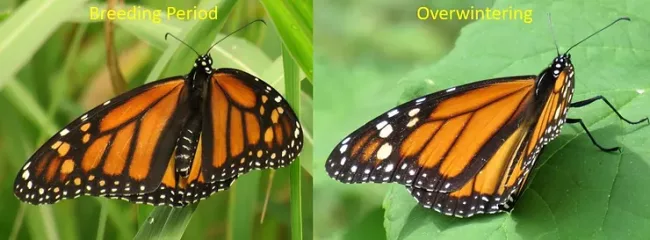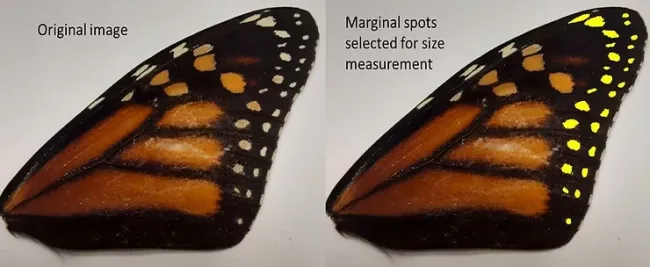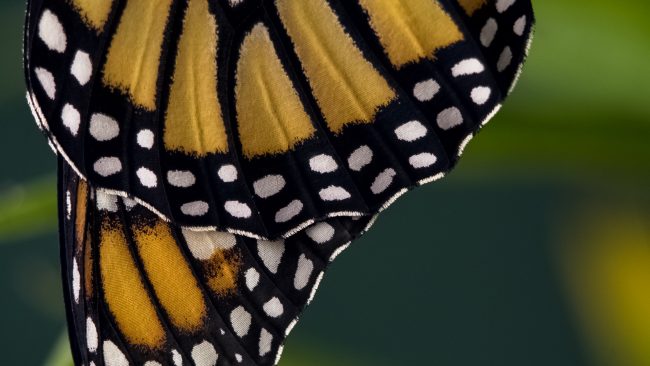Size and brilliance matter when it comes to the white spots on a monarch butterfly’s wings, a new study suggests.
In the research paper, titled “How the monarch got its spots: Long-distance migration selects for larger white spots on monarch butterfly wings,” migration studies expert Andy Davis at the University of Georgia posits that the migration selects for larger, brighter spots on the iconic insects’ wings. For a layperson’s interpretation of the study, see Davis’ article on the MonarchScience blog.
Davis collaborated with Mostafa Hassanalian, an associate professor of mechanical engineering at New Mexico Tech, and labeled the research “the most exciting project I’ve ever worked on.”
“What we learned from the monarch in this study can change human lives because it could be applicable to aerospace and drone technology,” Davis explained by phone. He said the findings are “the tip of the iceberg” and would likely spawn a new wave of butterfly research that would cause scientists to ask, ‘what does this spot pattern do?’

Andy Davis, Courtesy photo
The discrete white spots on the edge of a monarch butterfly’s wings appear to impact lift and drag aerodynamically. And the larger and brighter the white spots, the greater the advantage a monarch has in making its long trek to the Mexican mountains.
The study was the result of bioinspiration and biomimetics, said Hassanalian, who has been studying bird flight for years at his university’s Autonomous Flight and Aquatic Systems Laboratory to shed light on how to improve drone, aquatic and aerodynamic technology.
Bioinspiration is when you look at nature, you get inspired, and you apply that to any thought, Hassanalian explained. Biomimetics is when you mimic or replicate nature to explore certain outcomes. “Airplanes and submarines are all bioinspired,” he said.
Hassanalian’s and Davis’ research intersected because Davis’ once published a study on how darker orange wing colors in monarch butterflies contributes to their migration success. Earlier this year, Hassanalian published a study on how the color of bird wings effects avian flight.
For monarchs, what appears to matter is the relationship between the white spots and the black background on the the marginal wing edge. The black color absorbs heat and the white spots reflect it, creating a draft that favors more efficient flight, presumably assisting the tiny creatures in their migration from Canada to Mexico.
The research was based on digital measurements of 375 images of monarch wings archived in Davis’ personal collection of breeding, migratory and overwintering butterfly samples. Davis assumed they would find higher ratios of black on the overwintering samples, since Hassanalian’s prior research had suggested that darker wings facilitate more efficient flight.
But that was not the case. The overwintering monarch samples actually had less black on their wings–about 3% less. The also demonstrated about 3% more white on their wings.

Summer breeding monarch on left, overwintering monarch on right. See how bright the spots are on the overwintering one? Photo by Pat Davis
After the revelation that overwintering monarchs had 3% more white on their wings, Davis and team tapped the expertise of study co-author Paola Barriga, who had done previously photographed monarch butterfly specimens at museums. Co-author and undergraduate Christina Vu used computer imaging to analyze the actual size of the marginal spots on the images of the butterfly forewings. The spots of monarchs, queens, soldiers and four other non migrating butterflies related to the monarch were traced and measured, then the surface area was calculated to determine the percentage of the wing surface covered by the spots.
Researchers found that migratory monarchs generally have spots that cover about 2.5% of their wing surface, while non-migratory species’ white spots only cover 1 – 2%.
Davis’ working theory is that the spots work to reduce aerodynamic drag of the wing. The black portions of the wing are heating up under the sun, but the white spots are not, thus the confluence of air above the wing creates a “micro-eddy” that enhances flight efficiency.

Graduate student and study co author Cristina Vu measured the area occupied by the marginal wing spots. Photo courtesy Andy Davis
“Think about the implications for drone technology, for example, if it turns out that their flight efficiency can be improved by simply adding some white (and black) paint to their wings,” Davis wrote on his blog.
The study made headlines in major news outlets and generated support and skepticism from other scientists.
Ayse Tenger-Trolander, a biologist at the University of Chicago, questioned whether follow-up research will show that the spots actually help. “There’s a little part of me that wonders if some of these differences are due just to the way that the wing physically develops,” Tenger-Trolander told the New York Times.
“I’d be really interested in more aerodynamic measurements,” Mary Salcedo, a postdoctoral researcher at Cornell University who studies insect wings, told National Public Radio. “I’d love to see aerodynamic tests on their lift and drag coefficients.”
Karen Oberhauser, a monarch expert and director of the University of Wisconsin-Madison Arboretum labeled the white spot research “really interesting.” Oberhauser said she was among many who have examined hundreds of monarchs over the years, yet never considering possible geographic differences in their wing spots. “I can’t wait to see what his team finds out as they dig into the mechanisms by which these differences might affect flight dynamics,” she said.
David James, who has studied monarchs from Australia to California for decades and currently serves as a professor at Washington State University was skeptical. “It seemed superficial to me… 3% difference is not going to get me excited… and it appears that the spots of populations in Australia and New Zealand may be just as large,” he said.
Marcus Kronforst, an evolutionary biologist at the University of Chicago, told NPR that despite having worked on butterfly color patterns his whole life, he basically had never considered such possibilities. “It’s never crossed my mind that it might influence how the butterflies fly,” he said.
TOP PHOTO: Close up of monarch butterfly wings. Photo by Angela Guerra Walley
Related posts:
- Diminished monarch butterfly migration begins, NWF announces 22 percent drop in overwintering population
- Should we give up avocados to help save the monarch butterfly roosting sites?
- How to plan a successful butterfly garden
- Leverage summer heat and convert water guzzling turf to pollinator habitat
- Mostly native butterfly garden outperforms lawn every time
- A year in the life of an urban butterfly garden
- Downtown River walk plot converts to pollinator garden, creature haven
- Converting your Lawn to a Butterfly Garden
- Tropical Milkweed: To Plant it or Not is Not a Simple Question
Like what you’re reading? Don’t miss a single post from the Texas Butterfly Ranch. Sign up for email delivery, like us on Facebook, or follow us on Twitter, @monikam.


“may help” survive the trip to Mexico = speculation only at this point. A problem with this study is that the butterflies tested in the USA were not all fall migrants whereas the butterflies tested from the overwintering sites in Mexico were obviously all fall migrants.
The proper way to sample fall migrants from the USA would be to catch them from overnight roosts in the region between Minnesota and the Mexican border in Texas between late August and mid-October to see if the wing edges might contain progressively larger amounts of white. Dr. Davis and his research associates didn’t do that.
Maniacal science v.s. God’s beautiful creations!
I wonder if Monarchs in Hawaii have been studied for their white spots. They do not migrate.
Good question. –MM